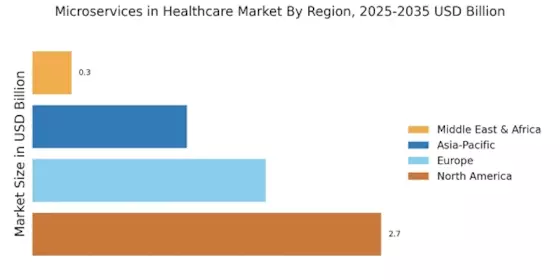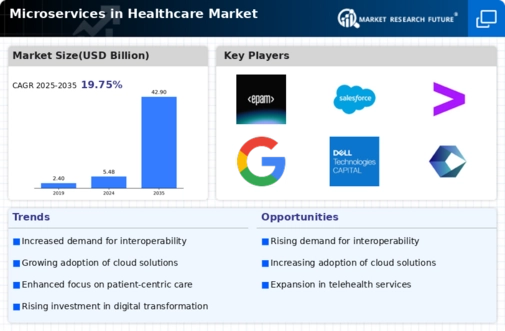North America : Innovation and Leadership Hub
North America leads the microservices in healthcare market, holding approximately 45% of the global share. The region's growth is driven by increasing demand for scalable healthcare solutions, regulatory support for digital transformation, and a robust IT infrastructure. The U.S. government has been actively promoting healthcare IT initiatives, which further catalyze market expansion. The second largest market is Europe, accounting for around 30% of the share, reflecting strong demand trends and regulatory frameworks.
The competitive landscape in North America is characterized by the presence of major players such as Amazon, Microsoft, and IBM, which are continuously innovating to enhance their service offerings. The U.S. is the leading country, with significant investments in healthcare technology and a focus on improving patient outcomes through microservices. This competitive environment fosters collaboration and innovation, positioning North America as a leader in the microservices healthcare market.
Europe : Regulatory Support and Growth
Europe is witnessing significant growth in the microservices in healthcare market, holding approximately 30% of the global share. The region benefits from stringent regulations that promote data security and interoperability, driving demand for microservices solutions. Countries like Germany and the UK are at the forefront, leveraging government initiatives to enhance healthcare delivery through technology. The largest market remains North America, while Europe is rapidly closing the gap with its robust regulatory framework and increasing investments in digital health.
Leading countries in Europe include Germany, the UK, and France, where healthcare providers are increasingly adopting microservices to improve operational efficiency and patient care. The competitive landscape features key players like IBM and Oracle, who are expanding their presence through strategic partnerships and innovative solutions. This dynamic environment is fostering a culture of innovation, making Europe a promising market for microservices in healthcare.
Asia-Pacific : Rapid Growth and Adoption
Asia-Pacific is rapidly emerging as a significant player in the microservices in healthcare market, holding approximately 20% of the global share. The region's growth is fueled by increasing healthcare expenditure, a rising population, and a growing emphasis on digital transformation. Countries like China and India are leading this trend, supported by government initiatives aimed at enhancing healthcare infrastructure and services. The largest market remains North America, while Asia-Pacific is gaining momentum with its innovative approaches to healthcare delivery.
In Asia-Pacific, China and India are the leading countries, with substantial investments in healthcare technology and a focus on improving patient outcomes. The competitive landscape is evolving, with local and international players like Salesforce and Red Hat entering the market. This influx of competition is driving innovation and collaboration, positioning Asia-Pacific as a burgeoning market for microservices in healthcare.
Middle East and Africa : Emerging Market with Challenges
The Middle East and Africa region is gradually developing its microservices in healthcare market, holding approximately 5% of the global share. The growth is driven by increasing healthcare investments, a rising demand for efficient healthcare delivery, and government initiatives aimed at improving healthcare systems. While the market is smaller compared to North America and Europe, it shows potential for growth as countries like South Africa and the UAE focus on digital health solutions to enhance patient care.
Leading countries in the region include South Africa and the UAE, where there is a growing interest in adopting microservices to streamline healthcare operations. The competitive landscape is still in its nascent stages, with a mix of local and international players beginning to establish a presence. This evolving market presents opportunities for innovation and investment, making the Middle East and Africa a region to watch in the microservices healthcare sector.



















Leave a Comment